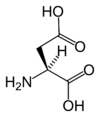Difference between revisions of "Aspartic acid" - New World Encyclopedia
({{Contracted}}) |
|||
| Line 1: | Line 1: | ||
| − | {{Claimed}} | + | {{Claimed}}{{Contracted}} |
{{NatOrganicBox | {{NatOrganicBox | ||
| image= [[Image:L-aspartic-acid-skeletal.png|100px|Chemical structure of Aspartic acid]][[Image:L-aspartic-acid-3D-sticks.png|90px|Chemical structure of the amino acid aspartate]]<br />Chemical structure of L-aspartic acid | | image= [[Image:L-aspartic-acid-skeletal.png|100px|Chemical structure of Aspartic acid]][[Image:L-aspartic-acid-3D-sticks.png|90px|Chemical structure of the amino acid aspartate]]<br />Chemical structure of L-aspartic acid | ||
Revision as of 20:02, 15 June 2007
  Chemical structure of L-aspartic acid | |
Aspartic acid | |
| Systematic (IUPAC) name | |
| (2S)-2-aminobutanedioic acid | |
| Identifiers | |
| CAS number | 56-84-8 |
| PubChem | 5960 |
| Chemical data | |
| Formula | C4H7NO4 |
| Mol. weight | 133.10 |
| SMILES | N[C@@H](CC(O)=O)C(O)=O |
| Complete data | |
Aspartic acid is an α-amino acid with the chemical formula HO2CCH(NH2)CH2CO2H. The L-isomer is one of the 20 proteinogenic amino acids, i.e. the building blocks of proteins. Its three letter code is asp, its one letter code is D, and its codons are GAU and GAC.[1] It is classified as an acidic amino acid, together with glutamic acid. Aspartic acid is pervasive in biosynthesis.
Role in biosynthesis of amino acids
Aspartic acid is non-essential in mammals, being produced from oxaloacetate by transamination. In plants and microorganisms, aspartic acid is the precursor to several amino acids, including four that are essential: methionine, threonine, isoleucine, and lysine. The conversion of aspartic acid to these other amino acids begins with reduction of aspartic acid to its "semialdehyde," HO2CCH(NH2)CH2CHO.[2] Asparagine is derived from aspartic acid via transamidation:
- HO2CCH(NH2)CH2CO2H + GC(O)NH2 HO2CCH(NH2)CH2CONH2 + GC(O)OH
(where GC(O)NH2 and GC(O)OH are glutamine and glutamic acid, respectively)
Other biochemical roles
Aspartic acid is also a metabolite in the urea cycle and participates in gluconeogenesis. It carries reducing equivalents in the malate-aspartate shuttle, which utilizes the ready interconversion of aspartate and oxaloacetate, which is the oxidized (dehydrogenated) derivative of malic acid. Aspartic acid donates one nitrogen atom in the biosynthesis of inositol, the precursor to the purine bases.
Neurotransmitter
Aspartate (the conjugate base of aspartic acid) stimulates NMDA receptors, though not as strongly as the amino acid neurotransmitter glutamate does.[3] It serves as an excitatory neurotransmitter in the brain and is an excitotoxin.
As a neurotransmitter, aspartic acid may provide resistance to fatigue and thus lead to endurance, although the evidence to support this idea is not strong.
Synthesis
Racemic aspartic acid can be synthesized from diethyl sodium phthalimidomalonate, (C6H4(CO)2NC(CO2Et)2).[4]
ReferencesISBN links support NWE through referral fees
- ↑ IUPAC-IUBMB Joint Commission on Biochemical Nomenclature. Nomenclature and Symbolism for Amino Acids and Peptides. Recommendations on Organic & Biochemical Nomenclature, Symbols & Terminology etc. Retrieved 2007-05-17.
- ↑ Nelson, D. L.; Cox, M. M. "Lehninger, Principles of Biochemistry" 3rd Ed. Worth Publishing: New York, 2000. ISBN 1-57259-153-6.
- ↑ Philip E. Chen, Matthew T. Geballe, Phillip J. Stansfeld, Alexander R. Johnston, Hongjie Yuan, Amanda L. Jacob, James P. Snyder, Stephen F. Traynelis, and David J. A. Wyllie. 2005. Structural Features of the Glutamate Binding Site in Recombinant NR1/NR2A N-Methyl-D-aspartate Receptors Determined by Site-Directed Mutagenesis and Molecular Modeling. Molecular Pharmacology. Volume 67, Pages 1470-1484.
- ↑ Dunn, M. S.; Smart, B. W. “DL-Aspartic Acid”Organic Syntheses, Collected Volume 4, p.55 (1963). http://www.orgsyn.org/orgsyn/pdfs/CV4P0055.pdf
See also
- Aspartate transaminase
- Sodium poly(aspartate), a synthetic polyamide
External links
Template:ChemicalSources
| Major families of biochemicals | ||
| Peptides | Amino acids | Nucleic acids | Carbohydrates | Nucleotide sugars | Lipids | Terpenes | Carotenoids | Tetrapyrroles | Enzyme cofactors | Steroids | Flavonoids | Alkaloids | Polyketides | Glycosides | ||
| Analogues of nucleic acids: | The 20 Common Amino Acids | Analogues of nucleic acids: |
| Alanine (dp) | Arginine (dp) | Asparagine (dp) | Aspartic acid (dp) | Cysteine (dp) | Glutamic acid (dp) | Glutamine (dp) | Glycine (dp) | Histidine (dp) | Isoleucine (dp) | Leucine (dp) | Lysine (dp) | Methionine (dp) | Phenylalanine (dp) | Proline (dp) | Serine (dp) | Threonine (dp) | Tryptophan (dp) | Tyrosine (dp) | Valine (dp) | ||
Credits
New World Encyclopedia writers and editors rewrote and completed the Wikipedia article in accordance with New World Encyclopedia standards. This article abides by terms of the Creative Commons CC-by-sa 3.0 License (CC-by-sa), which may be used and disseminated with proper attribution. Credit is due under the terms of this license that can reference both the New World Encyclopedia contributors and the selfless volunteer contributors of the Wikimedia Foundation. To cite this article click here for a list of acceptable citing formats.The history of earlier contributions by wikipedians is accessible to researchers here:
The history of this article since it was imported to New World Encyclopedia:
Note: Some restrictions may apply to use of individual images which are separately licensed.